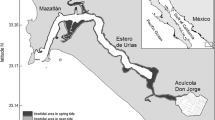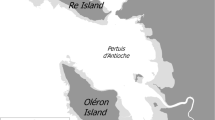Abstract
Determining the importance of stopover and staging areas to migrating shorebirds (Aves: Charadriiformes) is essential if such habitats are to be successfully protected. Migration chronology, species composition, length of stay, body condition, and estimated total abundance of shorebirds during spring and fall migratory periods of 2008 and 2009 were documented on Akimiski Island, Nunavut, Canada. Fourteen shorebird species were observed during spring point counts and 18 during fall. Semipalmated (Calidris pusilla) and White-rumped (C. fuscicollis) Sandpipers comprised about 80 % of all individuals observed. A greater number of species and individuals were observed during fall than spring in both years. Radio-transmitters attached to juvenile Semipalmated and Least (C. minutilla) Sandpipers indicated highly variable lengths of stay ranging up to 26 days in both species (Semipalmated Sandpiper averaged 6.5 ± 2.67 days, n = 12; Least Sandpipers averaged 7.25 ± 3.79 days, n = 8). In 2009, Semipalmated Sandpipers captured and weighed later in the season were significantly heavier than those captured earlier suggesting that this species is refueling while on Akimiski Island. A fall migration seasonal density of 5,267 (2,193–8,341) shorebirds/km2 was estimated given a residence probability (i.e., the probability of an individual being present in consecutive counts) of 0.906 ± 0.181. Assuming similar habitat value and shorebird density, an extrapolation of the seasonal plot density of 5,267 birds/km2 to the total 192 km2 mudflat habitat on Akimiski Island yields an estimate of 1,011,264 (421,098–1,601,429) shorebirds during fall migration, making Akimiski Island of Hemispheric importance as a staging site for migrant arctic-breeding shorebirds.




Similar content being viewed by others
References
Alexander SA, Gratto-Trevor CL (1997) Shorebird migration and staging at a large prairie lake and wetland complex: the quill lakes, Saskatchewan. Canadian Wildlife Service. Occasional paper no. 97. Environment Canada, Ottawa, pp 1–47
Andres BA, Browne BT (1998) Spring migration of shorebirds on the Yakutat Forelands, Alaska. Wilson Bull 110:326–331
Atkinson PW, Baker AJ, Bennett KA, Clark NA, Clark JA, Cole KB, Dekinga A, Dey A, Gillings S, González PM, Kalasz K, Minton CDT, Newton J, Niles LJ, Piersma T, Robinson RA, Baker AJ, González PM, Piersma T, Nils LJ, de Lima Serrano do Nascimento I, Atkinson PW, Clark NA, Minton CDT, Peck MK, Aarts G (2007) Rapid population decline in Red Knots: fitness consequences of decreased refueling rates and late arrival in Delaware Bay. Proc R Soc Lond B 271:875–882. doi:10.1098/rspb.2003.2663
Baker AJ, Gonzalez PM, Piersma T, Nils LJ, Serrano do Nascimento ID, Atkinson PW, Clark NA, Minton CDT, Peck MK, Aarts G (2004) Rapid population decline in Red Knots: fitness consequences of decreased refueling rates and late arrival in Delaware Bay. Proc R Soc Lond B 271:875–882
Bart J, Brown S, Harrington B, Morrison RIG (2007) Survey trends of North American shorebirds: population declines or shifting distributions? J Avian Biol 38:73–82. doi:10.1111/j.2007.0908-8857.03698.x
Bishop MA, Meyers PM, McNeley PF (2000) A method to estimate migrant shorebird numbers on the Copper River Delta, Alaska. J Field Ornithol 71:627–637
Blaney CS, Kotanen PM (2001) The vascular flora of Akimiski Island, Nunavut Territory, Canada. Can Field Nat 115:88–98
Clark KE, Niles LJ, Burger J (1993) Abundance and distribution of migrant shorebirds in Delaware Bay. Condor 95:694–705
Cohen JB, Karpanty SM, Fraser JD, Watts BD, Truitt BR (2009) Residence probability and population size of Red Knots during spring stopover in the mid-Atlantic region of the United States. J Wildlife Manage 73:939–945. doi:10.2193/2008-042
Dunn PO, May TA, McCollough MA, Howe MA (1988) Length of stay and fat content of migrant Semipalmated Sandpipers in Eastern Maine. Condor 90:824–835
Fair J, Paul E, Jones J, Barrett Clark A, Davie C, Kaiser G (2010) Guidelines to the use of wild birds in research. Ornithological Council, Washington DC
Farmer A, Durbian F (2006) Estimating shorebird numbers at migratory stopover sites. Condor 108:792–807
Farmer AH, Wiens JA (1999) Models and reality:time-energy trade-offs in Pectoral Sandpiper (Calidris melanotos) migration. Ecology 80:2566–2580
Frederiksen M, Fox AD, Madsen J, Colhoun K (2001) Estimating the total number of birds using a staging site. J Wildl Manage 65:282–289
Hands MH (2008) Shorebird (Charadriiformes) migration at selected sites throughout Kansas during 2002–2006. T Kansas Acad Sci 111:61–78
Hicklin PW (1987) The migration of shorebirds in the Bay of Fundy. Wilson Bull 99:540–570
Holmgren N, Ellegren H, Pettersson J (1993) Stopover length, body mass and fuel deposition rate in autumn migrating adult Dunlins Calidris alpina: evaluating the effects of moulting status and age. Ardea 81:9–20
Lehnen SE, Krementz DG (2005) Turnover rates of fall-migrating Pectoral Sandpipers in the Lower Mississippi Alluvial Valley. J Wildl Manage 69:671–680
Lyons JE, Haig SM (1995) Fat content and stopover ecology of spring migrant Semipalmated Sandpipers in South Carolina. Condor 97:427–437
Ma ZJ, Tang SM, Chen JK (2002) Chongming Island: a less important shorebird stopover site during southward migration. Stilt 41:35–37
MacDonald EC, Ginn MG, Hamilton DJ (2012) Variability in foraging behavior and implications for diet breadth among Semipalmated Sandpipers staging in the Upper Bay of Fundy. Condor 114:135–144
Manomet Center for Conservation Sciences (2005) Western hemisphere shorebird reserve network. http://www.manomet.org/WHSRN/. Accessed 10 Sept 2009
Morrison RIG (1984) Migration systems of some new world shorebirds. In: Burger J, Olla BL (eds) Shorebirds: migration and foraging behaviour, vol 6. Plenum Press, New York, pp 125–202
Morrison RIG, Harringtom B (1979) Critical shorebird resources in James Bay and Eastern North America. T N Am Wildl Nat Res 44:498–507
Morrison RIG, Aubry Y, Butler RW, Beyersbergen GW, Donaldson GM, Gratto-Trevor CL, Hicklin PW, Johnston VH, Ross RK (2001a) Declines in North American shorebird populations. Bull Wader Study Group 94:34–38
Morrison RIG, Gill Jr RE, Harrington BA, Skagen S, Page GW, Gratto-Trevor CL, Haig SM (2001b) Estimates of shorebird populations in North America. Canadian Wildlife Services Occasional Paper No 104, Environment Canada, Ottawa, Canada
Morrison RIG, McCaffery BJ, Gill RE, Skagen SK, Jones SL, Page GW, Gratto-Trevor CL, Andres BA (2006) Population estimates of North American shorebirds. Bull Wader Study Group 111:67–85
Morrison RIG, Davidson NC, Wilson JR (2007) Survival of the fattest: body stores on migration and survival in red knots Calidris canutus islandica. J Avian Biol 38:479–487
Myers JP (1987) Shorebird migration. Delaware Cons 30:27–30
Nguygen P, Nol E, Abraham KF (2006) Nest success and habitat selection of the Semipalmated Plover on Akimiski Island, Nunavut. Wilson Bull 115:285–291
Nicholls RJ, Wong PP, Burkett VR, Codignotto JO, Hay JE, McLean RF, Ragoonaden S, Woodroffe CD (2007) Coastal systems and low-lying areas. In: Parry ML, Canziani OF, Palutikof JP, van der Linden PJ, Hanson CE (eds) Climate change 2007: impacts, adaptation and vulnerability. Contribution of working group II to the fourth assessment report of the intergovernmental panel on climate change. Cambridge University Press, Cambridge, pp 315–356
NOAA: National Oceanic and Atmospheric Administration (2006) MMAB Sea Ice analysis. http://polar.ncep.noaa.gov/seaice/Analyses.html. Accessed 25 Sept 2010
O’Reilly KM, Wingfield JC (1995) Spring and autumn migration in Arctic shorebirds: same distance, different strategies. Am Zool 35:222–233
Piersma T, Baker AJ (2000) Life history characteristics and the conservation of migratory shorebirds. In: Gosling LM, Sutherland WJ (eds) Behaviour and conservation. Cambridge University Press, Cambridge, pp 105–124
Pollock LA (2011) The importance of Akimiski Island, Nunavut, as a stopover site for migrant shorebirds. Masters of Science thesis, Trent University, Peterborough, Ontario, Canada
Pyle P (1997) Identification guide to North American birds: part 1. Slate Creek Press, Bolinas
Recher HF (1966) Some aspects of the ecology of migrant shorebirds. Ecology 47:393–407
Skagen SK, Knopf FL (1994) Migrating shorebirds and habitat dynamics at a prairie wetland complex. Wilson Bull 106:91–105
Skagen SK, Granfors DA, Melcher CP (2008) On determining the significance of ephemeral continental wetlands to North American migratory shorebirds. Auk 125:20–29. doi:10.1525/auk.2008.125.1.20
Taylor AR, Lanctot RB, Powell AN, Kendall SJ, Nigro DA (2011) Residence time and movements of postbreeding shorebirds on the northern coast of Alaska. Condor 113:779–794
Urbanek S, Iacus SM (2009) Program R version 2.10.0. http://www.R-project.org
Warnock N (2010) Stopping vs. staging: the difference between a hop and a jump. J Avian Biol 41:621–626
Warnock N, Bishop MA (1998) Spring stopover ecology of migrant Western Sandpipers. Condor 100:456–467
Warnock N, Haig SM, Oring LW (1998) Monitoring species richness and abundance of shorebirds in the Western Great Basin. Condor 100:589–600
White GC (1999) Program MARK: mark and recapture parameter estimation, version 51. Colorado State University, Colorado
Williams TD, Warnock N, Takekawa JY, Bishop MA (2007) Flyway-scale variation in plasma triglyceride levels as an index of refueling rate in spring-migrating Western Sandpipers. Auk 124:886–897
Wilson WH Jr (1990) Relationship between prey abundance and foraging site selection by Semipalmated Sandpipers on a Bay of Fundy Mudflat. J Field Ornithol 61:9–19
Acknowledgments
We thank Guy Morrison and Ken Ross of Environment Canada for providing the aerial survey data. This research would not have been possible without the help of field assistants Ben Walters, Danica Hogan, Andrée Messier, Shane Pratt, Gabriel Foley, Katie Walker, and Mitchell Beck. We would also like to thank Tyler Hoar, Jean Iron, and Mark Peck for assistance in the field on Akimiski Island. Financial support for this study was provided by the Ontario Ministry of Natural Resources (OMNR), the National Sciences and Engineering Research Council (NSERC), the Northern Scientific Training Program (NSTP), the Symons Trust Fund for Canadian Studies, and the International Polar Year (IPY) ArcticWOLVES Project (INAC).
Author information
Authors and Affiliations
Corresponding author
Rights and permissions
About this article
Cite this article
Pollock, L.A., Abraham, K.F. & Nol, E. Migrant shorebird use of Akimiski Island, Nunavut: a sub-arctic staging site. Polar Biol 35, 1691–1701 (2012). https://doi.org/10.1007/s00300-012-1211-6
Received:
Revised:
Accepted:
Published:
Issue Date:
DOI: https://doi.org/10.1007/s00300-012-1211-6




